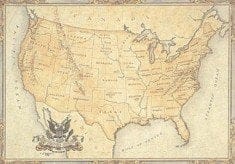
Welcome to MovieMaker’s 2014 edition of the Best Places to Live and Work as a Moviemaker! We’re counting down through our Top 10 Big Cities, Top 5 Small Cities, and Top 5 Towns—releasing one location a day for the entire month of January. The full list, published in MovieMaker‘s Winter 2014 issue, will be available on newsstands January 28.
Notice that we’re referring this year to ‘places’ instead of ‘cities.’ Unlike previous years where locations were pitted against each other in a single pool, this year we separated the list into three distinct categories: Big Cities (pop. 500,000 and up), Small Cities (pop. 100,000 to 500,000), and Towns (pop. 100,000 and under). We hope this has leveled the playing field, to distinguish smaller communities with tremendous resources, like Asheville, North Carolina, that fulfill entirely different moviemaking needs than 800lb. gorilla cities like Los Angeles or New York City.
Note too that these rankings aren’t all “Show Me the Money!” While state incentives matter in choosing where to make a film, there’s more to life than tax credits. Ask yourself: Does this place have the right atmosphere and locations for my moviemaking style—and my lifestyle? Are there opportunities to network with other film professionals? Can I take some classes locally to enhance my skills? Can I afford to live here? Are there independent theaters and groups that would screen and support my work? Are there experienced crew and production facilities to choose from?
After months of research, interviews, and mathematical formulas, we boiled the rankings down to the essential elements. All locations were rated according to six criteria: Film Production in 2013 (shooting days, number of productions, dollars generated), Film Community and Culture (film schools, festivals, independent theaters, film organizations), Access to Equipment and Facilities, Tax Incentives, Cost of Living, and a General category that included lifestyle, weather, and transportation. These factors were compiled into a rubric, distributed to film commissions all across the country, and the resulting information, along with additional insight from sites like bestplaces.net and filmproductioncapital.com, helped provide the final results.
Did your place of choice make the list? If not, maybe you should choose again if you’re serious about rooting yourself in a location that’s conducive to your career and life goals – or drop us a comment proposing a place we overlooked this year. Remember to check back for our favorite Big Cities, Small Cities and Towns, one a day from Monday to Friday for the rest of January, and pick up a copy of our Winter 2014 issue later this month for the full article! In the meantime, we’re kicking off the countdown with our number 10 Big City, a gem of the West Coast.
TOP 10 BIG CITIES
#10. San Francisco
Few cities are as majestic as San Francisco—colorful city streets and postcard panoramas with a long history of moviemaking dating back to Charlie Chaplin, the silent film era, and The Jazz Singer in 1927. With its hills and bridges, redwoods and coasts, moviemakers have exceptional options for their projects: There’s Chinatown, the Painted Ladies, the waterfront, Alcatraz, the Golden Gate Bridge, Fort Point, City Hall, and those unforgettable cable cars. “You can’t throw a rock in San Francisco without hitting a gorgeous old building, a stunning vista or a beautiful park,” said producer Michael Lannan (Remember Me). “Sometimes all three at once!”
Working on the HBO series Looking, Lannan added: “The city’s idiosyncrasies surround you, and we found a lot of inspiration just wandering around. Our goal was to capture that beauty, and also show a city that feels real and lived-in.”
Bloomberg Businessweek voted San Francisco as “America’s Best City.” And neighboring Silicon Valley has attracted some of the most innovative technology workers from all over the world and film schools such as the San Francisco School of Digital Filmmaking and Berkeley Digital Film Institute emphasize the future of moviemaking. Moviemaking legends like Francis Ford Coppola have set up shop downtown on Kearny Street (American Zoetrope) and George Lucas’ Skywalker Ranch continues to make movie magic in nearby Marin County. Shooting in San Francisco, you’re eligible for a 20% tax credit for feature films with a $1-75 million budget so long as 75% of its production takes place in California. Additionally, credit can be used to offset income, sales and use tax for tax years starting after January 1, 2011.
Living in San Francisco, with its famously liberal, artistic scene, is indeed a lovely experience—even Woody Allen, with his Bay Area-set Blue Jasmine, described it to Time Out London as “the good West Coast.” We just wish it were a little (OK, a lot) cheaper.
For more information on San Francisco, visit the San Francisco Film Commission at filmsf.org.
Check back every day for the rest of January to see what other places made the list! MM
To subscribe to MovieMaker Magazine, click here.
Share:




